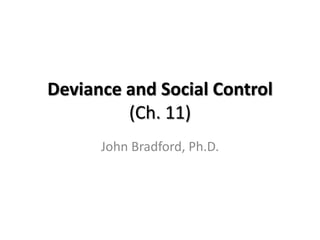
Bradford mvsu spring 2013 deviance and crime
- 1. Deviance and Social Control (Ch. 11) John Bradford, Ph.D.
- 2. Deviance • Deviance is the ‘flip side of conformity’: Deviance/Conformity • Deviance = any act that violates the norms of a particular group of people at a particular point in time (pg. 173)
- 3. Deviance 1. Norms vary across societies: what is considered to be deviant changes from place to place. – Example: chewing gum in Singapore – It is impossible to find any specific act that is regarded a deviant in every culture. 2. Norms change over time – Example: public attitudes about slavery, women’s right to vote, homosexuality, etc. 3. Norms vary *within* a particular society: different subgroups have different norms – Example: ‘drinking until you pass out’ may be a norm in some groups.
- 4. Sociological Theories of Deviance • Durkheim was interested in suicide rates. His study, Suicide (1897) was one of the first sociological studies to use statistical analysis. • He argued that as societies become larger and more complex, there was less and less agreement and commonality among people about their norms and values.
- 5. Sociological Theories of Deviance • Egoism = occurs when people are not well integrated into society. – Examples: unmarried people less integrated than married people; Protestants were less integrated than Catholics; – The less integrated into society you were, the more likely you were to commit suicide
- 6. Sociological Theories of Deviance • Anomie = a state wherein society fails to exercise adequate regulation of the goals and desires of individual members; normlessness; lack of social constraint. • Lack of moral regulation makes suicide more likely
- 7. Sociological Theories of Deviance • Robert K. Merton argued that anomie is built into the structure of modern society. • Anomie occurs when the norms of a society do not match its social structure.
- 8. Sociological Theories of Deviance 1. All societies have commonly accepted goals for their members. 2. Each society establishes what it considers to be legitimate ways, or means, to reach these valued goals. • In modern society, there is a disjunction (‘gap’) between goals and legitimate means.
- 9. Responses to Anomie Mode of adaptation Cultural goals Institutionalized means Conformity Accept Accept Innovation Accept Reject Ritualism Reject Accept Retreatism Reject Reject Rebellion Reject, substitute new Reject, substitute new goals means
- 10. Legitimate vs. Illegitimate Means • Richard A. Cloward and Lloyd E. Ohlin (two students of Merton) argue that just as legitimate means to success are unequally distributed in society, so are illegitimate means. – Example: if you are poor or illiterate you probably will not become a computer hacker or bank robber.
- 11. Learning to be deviant • Deviance is often a learned social behavior. • Becker found that becoming a marijuana smoker involved 3 separate processes: 1. Learning to smoke 2. Learning to perceive the effects 3. Learning to enjoy the effects
- 12. Labeling Theory • This slide is taken from a previous lecture on the ‘power of the situation’: the point is that we have to observe behavior before we can label people according to various personality types. CAUSE = Relevant Labeling of Perceived Behavior Personality situation Sociological view of human behavior
- 13. Labeling Theory • However, once you are labeled, both your behavior and other people’s perception of your behavior will change! You will begin to conform to the label, and the perception of others will also conform to the label. CAUSE = Behavior Labeling of Perceived Personality situation Affects of label on: 1. how you act and 2. how others perceive your actions
- 14. Labeling Theory • Labeling Theory focuses not on the one who commits the deviant act but on the response of the audience. • Primary deviance = first time deviant act is committed; can be for all sorts of reasons. • Secondary deviance = the deviant behavior that arises because of, or in response to, society’s reaction to their deviance.
- 15. Stigma • Stigma = negative social labels • Types of stigmas (Goffman): 1. Abominations of the body 2. Blemishes of individual character: labels of mental disorder, dishonesty, alcoholism, bankruptcy, etc. 3. Tribal stigmas: being discredited for membership in a particular racial, religious, or ethnic group • Discredited Identity vs. Discreditable Identity
Notas do Editor
- Even if a given situation does not predetermine how one is to behave, it often establishes the relevant range of expected behaviors, i.e. defines a social universe within which some actions make sense and others do not. For example, in the context of a chess game, yelling ‘fire’ can only make sense as a change of the very definition of the situation, i.e. context of relevance.
